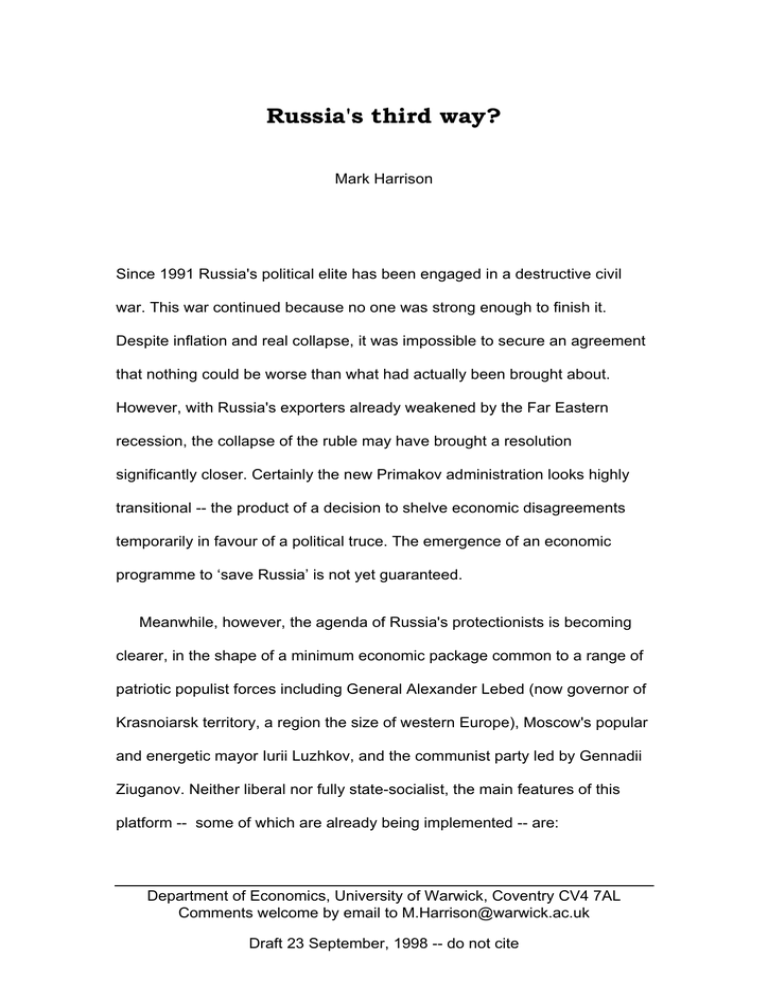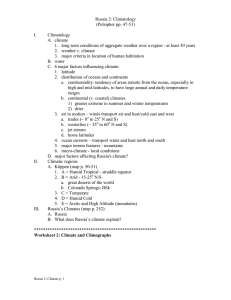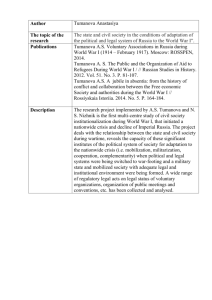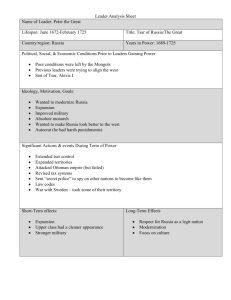Russia's third way?
advertisement

Russia's third way? Mark Harrison Since 1991 Russia's political elite has been engaged in a destructive civil war. This war continued because no one was strong enough to finish it. Despite inflation and real collapse, it was impossible to secure an agreement that nothing could be worse than what had actually been brought about. However, with Russia's exporters already weakened by the Far Eastern recession, the collapse of the ruble may have brought a resolution significantly closer. Certainly the new Primakov administration looks highly transitional -- the product of a decision to shelve economic disagreements temporarily in favour of a political truce. The emergence of an economic programme to ‘save Russia’ is not yet guaranteed. Meanwhile, however, the agenda of Russia's protectionists is becoming clearer, in the shape of a minimum economic package common to a range of patriotic populist forces including General Alexander Lebed (now governor of Krasnoiarsk territory, a region the size of western Europe), Moscow's popular and energetic mayor Iurii Luzhkov, and the communist party led by Gennadii Ziuganov. Neither liberal nor fully state-socialist, the main features of this platform -- some of which are already being implemented -- are: Department of Economics, University of Warwick, Coventry CV4 7AL Comments welcome by email to M.Harrison@warwick.ac.uk Draft 23 September, 1998 -- do not cite n increased government outlays on industry, both for investment and for remilitarisation; in Nezavisimaia gazeta Luzhkov was recently reported (19/9/98) to have signed an agreement with the Russian government and two key aerospace contractors, Rybinskie Motory and Liul’ka-Saturn, to develop a new generation of rocket motors n raising government revenues by reimposing a state monopoly on the sale of alcohol and tobacco; measures to this end have already been both rumoured and denied, while Luzhkov is known to advocate extending their coverage to the sale of audio and video cassettes; implicitly, this involves abandoning the effort to replace occasional income confiscation by the tax police at gunpoint with fair and effective income taxation by consent n import levies on consumer products for both revenue and effective protection, while encouraging the import of equipment for industrial reconstruction n an export tax linked to currency controls in the shape of a higher share of forced sales of hard currency earnings to the central bank n a partial default on government debt accompanied by discrimination in favour of domestic creditors -- not only bondholders but public employees owed wage arrears. The most obvious symptom of the crisis -- the bank collapse resulting from the ruble crisis and debt default -- is being handled by a mixture of liquidation and nationalisation. The government is printing enough money to buy back its 2 bonds held by domestic banks, supplying those which are still viable with enough liquidity to meet interbank obligations and liabilities to depositors (whether the cash will be used for these purposes remains to be seen). Others will be taken into public ownership and may be liquidated. But the Russian financial services sector is not now open to foreign competition and outsider takeovers which could have assisted the process of liquidating insolvent institutions and spreading future risks, and will certainly remain closed for the foreseeable future. Protectionist tendencies are pervasive not just in national politics but also at the regional level. As production falls and prices rise, many of Russia's regions, including Lebed’s Krasnoiarsk, are imposing their own controls on prices and regional exports. There are proposals for food rationing in foodsurplus regions, as in the winter of 1991/92, the purpose of which is not just to distribute food fairly within the region but also to limit regional exports and exclude non-residents from the internal food market of the region. Luzhkov, responsible for Russia's most numerous food-deficit population, rails against the surrounding regions which are blocking food supplies to Moscow, while blaming city crime on outsiders and also maintaining the system (in defiance of a supreme court ruling) which denies residence rights in Moscow to outsiders. (For sheer extremism, however, none of these remotely approaches Lebed’s recent threat of a Russian civil war fought with nuclear weapons.) Because the protectionist alternative invokes producer interests and 3 involves monetary expansion, a Keynesian justification is often suggested (see for example Meghnad Desai in The Guardian, 21/9/98). But Russia’s problem is not deficient demand. If devaluation and monetary expansion threaten serious inflation when output is 50 per cent below the previous peak and hundreds of thousands are being thrown out of work in Moscow alone, a Keynesian prescription does not on the face of it apply. Russia’s problem lies on the supply side, in the huge costs of contracting when the country is run by thieves. Some lessons of the Keynesian tradition are certainly relevant. Russia has found out that unregulated short-term capital mobility can lead to excess volatility. When real income cuts are inevitable, inflation may achieve the necessary result more equitably and with a lower level of conflict than wage cuts or wage arrears. In one possible scenario a controlled inflation combined with controls on the capital account could form part of a more comprehensive recovery package. Combined with the protectionist regime such a package could bring about a degree of recovery. The obvious dangers are that a commitment to limited inflation and limited controls may not be credible, and indeed may be intended by some parties as deliberate first steps towards destruction of the market economy. However, a political truce may grant Primakov or his successor greater credibility. Some renationalisation and an extension of government controls which fell short of recreating a Soviet-type planned economy might restrict rent-seeking and free-riding, and lower transaction 4 costs, freeing up the supply side by ensuring that economic agents know where they stand, even if where they stand is way down a reconstructed administrative hierarchy. Thus, an inward-looking restoration of economic activity is possible and cannot be ruled out. However, conscripting Keynes to support this process is fairly cynical. Russia today is ruled not by high-minded technocrats looking for a recovery programme which will serve the national interest, but by a corrupt, fragmented oligarchy of cops and robbers which are hard to differentiate morally one from another. Contrasts between Russian and western assessments of Primakov are instructive. To liberal-minded people in the west Primakov is an improvement because at least he is not a thief. To similar people in Russia Chernomyrdin was better because, even if a thief, at least he was not once a policeman. A focus on the protectionist programme for Russia does not imply that there is some superior alternative waiting to be implemented. In Russian public opinion both liberalism and socialism have been thoroughly discredited, whether or not they were ever really tried. Today Russia is seeking a ‘third way’ in a market economy under a protectionist corporate state. Can this third way do more than combine the worst of both worlds -- the militarisation and inefficiency of state socialism, and the corruption and inequalities of an insufficiently regulated market economy? There are many alternative historical precedents, as the twentieth century histories of Italy, Spain, Japan, Germany, and Argentina suggest, but Russia will not be bound 5 by precedent. The possible inward- and outward-looking foreign policy correlates of such a path also deserve analysis. As social scientists we should remain open to the possibility that Russia will produce something new. 6







